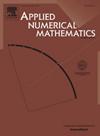静止无感应磁流体动力系统基于牛顿迭代的高效两网格算法
IF 2.4
2区 数学
Q1 MATHEMATICS, APPLIED
引用次数: 0
摘要
本文提出并分析了一种基于牛顿迭代的两网格算法求解静止无感应磁流体动力系统。该方法首先在网格大小为H的粗网格上求解一个小型非线性系统,然后在网格大小为H的细网格上求解两个线性问题。这些线性问题具有相同的刚度矩阵,但仅在其右侧有所不同。新方法改进了粗网格和细网格之间的尺度,同时近似解保持了与传统方法相同的收敛阶。利用符合H0(div,Ω)×L02(Ω)的有限元对对电流密度和电势进行离散,确保离散电流密度完全无发散。严格推导了稳定性和收敛性分析,并给出了速度的l2误差估计。数值实验验证了理论预测和方法的有效性。本文章由计算机程序翻译,如有差异,请以英文原文为准。
An efficient two-grid algorithm based on Newton iteration for the stationary inductionless magnetohydrodynamic system
In this paper, we propose and analyze a two-grid algorithm based on Newton iteration for solving the stationary inductionless magnetohydrodynamic system. The method involves first solving a small nonlinear system on a coarse grid with grid size H, followed by solving two linear problems on a fine grid with grid size h. These linear problems share the same stiffness matrix but differ only in their right-hand sides. The scaling between the coarse and fine grids is improved by our new method, while the approximate solution retains the same order of convergence as that observed in conventional methods. Furthermore, -conforming finite element pairs are utilized to discretize the current density and electric potential, ensuring that the discrete current density is exactly divergence-free. Stability and convergence analyses are rigorously derived, and -error estimates for the velocity are provided. Numerical experiments are presented to verify the theoretical predictions and demonstrate the efficiency of the proposed method.
求助全文
通过发布文献求助,成功后即可免费获取论文全文。
去求助
来源期刊

Applied Numerical Mathematics
数学-应用数学
CiteScore
5.60
自引率
7.10%
发文量
225
审稿时长
7.2 months
期刊介绍:
The purpose of the journal is to provide a forum for the publication of high quality research and tutorial papers in computational mathematics. In addition to the traditional issues and problems in numerical analysis, the journal also publishes papers describing relevant applications in such fields as physics, fluid dynamics, engineering and other branches of applied science with a computational mathematics component. The journal strives to be flexible in the type of papers it publishes and their format. Equally desirable are:
(i) Full papers, which should be complete and relatively self-contained original contributions with an introduction that can be understood by the broad computational mathematics community. Both rigorous and heuristic styles are acceptable. Of particular interest are papers about new areas of research, in which other than strictly mathematical arguments may be important in establishing a basis for further developments.
(ii) Tutorial review papers, covering some of the important issues in Numerical Mathematics, Scientific Computing and their Applications. The journal will occasionally publish contributions which are larger than the usual format for regular papers.
(iii) Short notes, which present specific new results and techniques in a brief communication.
 求助内容:
求助内容: 应助结果提醒方式:
应助结果提醒方式:


